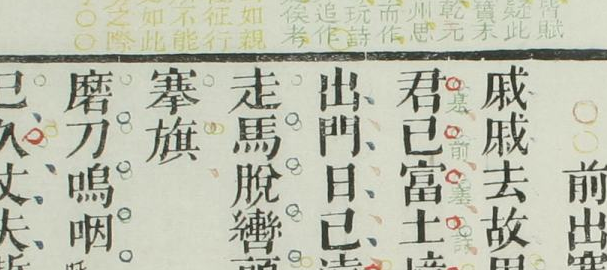In this post, inspired by a fun twitter thread by Shannon Supple, Curator of Rare Books at Smith College, on annotation (so many month ago now!), I’m going to introduce some of the basic features of textual annotation/punctuation – sometimes called judou 句讀 (reading marks) or pidian 批點 (comment marks) – in Chinese printed books.1
I first learned classical Chinese with Alvin P. Cohen at UMass, Amherst. This had some influence on my undergraduate social life, because Dr. Cohen, like many a hard-nosed philologist before him, believed in teaching unpunctuated classical Chinese. I spent countless hours before each 50 minute class trying to punctuate texts, look up characters, and pretend I had the faintest idea of what was happening. My notes from those days show it was not a pretty sight. (I’ll add a photo when I am back stateside.)
Because texts without punctuation can be a pain, people began punctuating Chinese early in its history. Consider this 7th century colophon to the Lotus Sutra found by Imre Galambos:
I punctuated this sūtra for beginner students who read it but are unfamiliar with the segmentation of the text. I neither paid attention to larger sections, nor considered their beginning and end. For the most part segments consist of four characters and I started punctuating them when the segments did not comprise four characters. But for four-character segments I added no dots whatsoever….In this manner, I tentatively distinguished them. Let those who see this later not blame me for using red marks and say that the punctuation is flawed. 余為初學讀此經者不識文句,故憑點之。亦不看科段,亦不論起盡,多以四字為句,若有四字外句 者,然始點之;但是四字句者,絕不加點。別為作為(帷委反);別行作行(閑更反)。如此之流,聊 復分別。後之見者,勿怪下朱,言錯點也。2
Continue reading “Things You Can Do with Woodblocks (3): Punctuation/annotation”
- A good starting point for learning about this is: David L. Rolston, Traditional Chinese Fiction and Fiction Commentary: Reading and Writing Between the Lines (Stanford University Press, 1997) ↩
- Imre Galambos, “Punctuation Marks in Medieval Chinese Manuscripts,” in Manuscript Cultures: Mapping the Field, ed. Jan-Ulrich Sobisch, Dmitry Bondarev, and Jörg Quenzer (De Gruyter, 2014), 352. ↩
